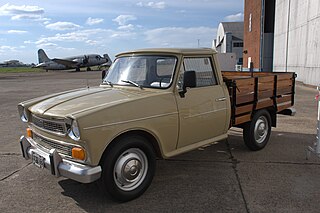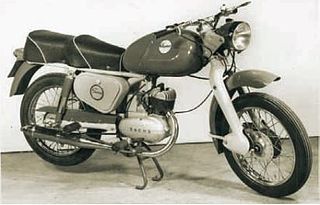
The automotive industry comprises a wide range of companies and organizations involved in the design, development, manufacturing, marketing, selling, repairing, and modification of motor vehicles. It is one of the world's largest industries by revenue.

S.C. Automobile Dacia S.A., commonly known as Dacia, is a Romanian car manufacturer that takes its name from the historical region that constitutes present-day Romania. The company was established in 1966. In 1999, after 33 years, the Romanian government sold Dacia to the French car manufacturer Groupe Renault. It is Romania's largest company by revenue and the largest exporter, constituting 8% of the country's total exports in 2018. In 2021, the Dacia marque sold 537,074 passenger and commercial vehicles.

A diesel–electric transmission, or diesel–electric powertrain, is a transmission system for vehicles powered by diesel engines in road, rail, and marine transport. Diesel–electric transmission is based on petrol–electric transmission, a transmission system used for petrol engines.

The Hindustan Ambassador is an automobile that was manufactured by Hindustan Motors of India from 1957 to 2014, with improvements and changes over its production lifetime. The Ambassador was based on the Morris Oxford series III model, first made by Morris Motors Limited at Cowley, Oxford in the United Kingdom from 1956 to 1959.

The Nissan Laurel is a front-engine, rear-drive two- and four-door sedan manufactured and marketed by Nissan from 1969 to 2002. Introduced in 1968 as a new model positioned above the 1968 Datsun Bluebird 510, the Laurel offered the luxury of the Nissan Cedric 130 in a smaller size. In Japan, the Laurel was marketed solely as a Nissan model, rather than a Datsun model.

The GAZ-M20 "Pobeda" is a passenger car produced in the Soviet Union by GAZ from 1946 until 1958. It was also licensed to the Polish Passenger Automobile Factory and produced there as the FSO Warszawa. Although usually known as the GAZ-M20, an original car's designation at that time was just M-20: M for "Molotovets".

The Gloria is a large luxury car made from 1959 by the Prince Motor Company, and later by Nissan Motors since its merger with the former - hence being originally marketed as Prince Gloria and later as Nissan Gloria. Initially based on the smaller Prince Skyline, the Gloria line was merged with Nissan Cedric starting with 1971 models and both continued until 2004, when they were both replaced by Nissan Fuga.

The Nissan Cedric is a large automobile produced by Nissan since 1960. It was developed to provide upscale transportation, competing with the Prince Skyline and Gloria which were later merged into the Nissan family. In later years, the Nissan Skyline was positioned as a sports sedan/coupe, whereas the Nissan Gloria was turned into a sporty version of the Cedric.
The Kaiser-Frazer Corporation was an American automobile company. It was founded jointly by industrialist Henry J. Kaiser and automobile executive Joseph W. Frazer. In 1947, the company acquired the automotive assets of Graham-Paige, of which Frazer had become president near the end of World War II. Kaiser-Frazer was one of a few US automakers to achieve success after World War II, if only for a few years. Joseph W. Frazer left the company in 1949, replaced as president by Henry's son Edgar F. Kaiser.

Industrias Kaiser Argentina S.A. was an Argentine automobile manufacturer established in 1956 as a joint venture with Kaiser Motors of the United States. Headquartered in Santa Isabel, Córdoba, the automaker produced a variety of Kaiser Jeep vehicles and American Motors Corporation (AMC) models, including Argentina's most iconic car, the Torino, before partnering with France's Renault, which bought it out in 1970.

SIAM is an Argentine home appliance brand, currently owned by "Grupo Industrial Newsan", a leader of the segment in the region. The original "Siam Di Tella" company was founded in Buenos Aires by Torcuato di Tella in 1911, established as a manufacturer of mechanical bread machines. Subsequently, production was diversified by incorporating the production of refrigerators, washing machines, kitchens, televisions, scooters, vans, automobiles, and elements for private industry and the public sector, such as oil pumping equipment, large electrical transformers, steel pipes and generators for diesel-electric locomotives. By the 1940s, the company became the largest metalworking industry in South America.

The Diamond T Company was an American automobile and truck manufacturer. They produced commercial and military trucks.

Hispano-Argentina was an Argentine automotive and engineering company that manufactured automobiles, military vehicles, engines, weaponry, and parts for public works.

A car, or an automobile, is a motor vehicle with wheels. Most definitions of cars state that they run primarily on roads, seat one to eight people, have four wheels, and mainly transport people, not cargo. French inventor Nicolas-Joseph Cugnot built the first steam-powered road vehicle in 1769, while French-born Swiss inventor François Isaac de Rivaz designed and constructed the first internal combustion-powered automobile in 1808.

The Rastrojero is a small utility pickup truck with a capacity of half-ton designed by Raúl Gómez and built by the Argentine government-owned airplane manufacturer IAME from 1952 to 1980. It owes its name to its purpose of being driven on crop residue (rastrojos). Over 33,000 of these trucks were manufactured.

Industrias Aeronáuticas y Mecánicas del Estado was a state-owned entity and autarchic conglomerate of factories of Argentina created in 1951 to promote the manufacture of aircraft and automobiles during the Juan Perón administration.

The Institec Justicialista was a line of cars produced by the government of Argentina via IAME from 1954 to 1955 as an attempt to develop a native Argentine automotive industry. It used a front-engine, front-wheel-drive layout with a two-stroke two-cylinder engine derived from a German DKW design and a conventional metal body. Due to the insistence of General Juan Domingo Perón a sports car prototype was made, a two-seat version was showcase as roadster in the Paris Motor Show. The prototype was repurposed Porsche with a fiberglass body powered by a 1.5-liter air-cooled Porsche flat-four engine and a Porsche four-speed gearbox driving the front wheels.

The Dodge GTX is a muscle car manufactured by Chrysler-Fevre Argentina S.A. under the Dodge brand. It was a development made on the basis of the 1960/66 platform A, consisting of a coupe without studs (hardtop) with a sporty cut, muscular, aggressive, aerodynamic and high-performance design. Due to its design, it was listed as one of the few muscle cars made in Argentina.

Chrysler Fevre Argentina S.A. was the Argentina subsidiary of US-based automotive manufacturer Chrysler Corporation. Originally established in 1890 as a supplier for tanning industry, the firm began to commercialise vehicles after an agreement signed with Dodge Brothers Company in 1916, which allowed it to import and commercialise automobiles and trucks in Argentina.

Puma, pumita, pumarola or pumasaki are the names given to a motorcycle created in Argentina in 1952. It became an emblem of Cordoba and a sign of the industrialization of the country's five-year plan. Made entirely by Argentine workers and with very accessible procurement plans, it quickly achieved popularity among the working classes. Its simple design and mechanical engineering made this motorcycle a symbol of the splendor of those days. Five series were presented, although the third only remained a prototype.


















